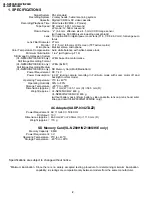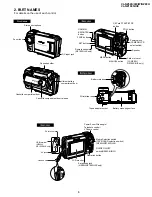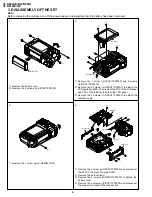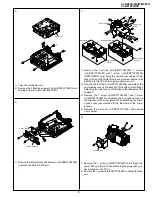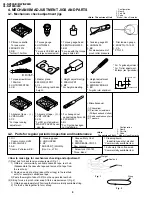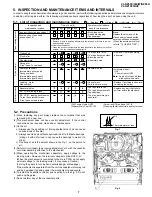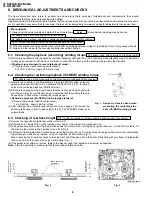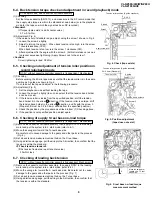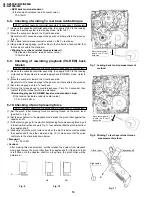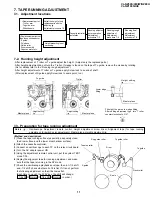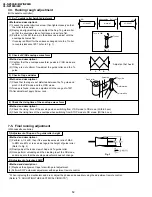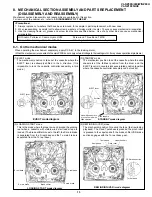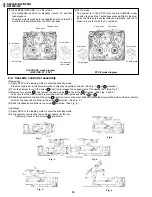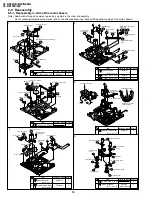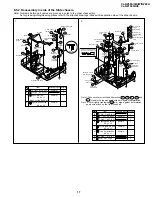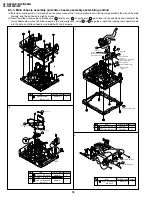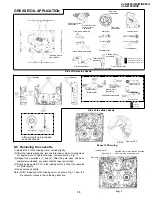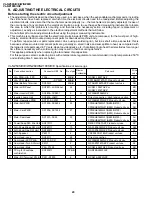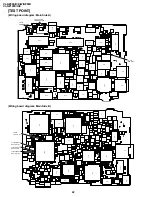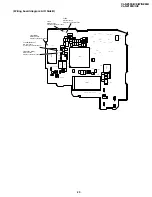
8
VL-NZ50S/H/E/W/NZ80H
VL-NZ100S/H/E
6. MECHANICAL ADJUSTMENTS AND CHECKS
The items discussed here relate to general on-site servicing (field servicing). Adjustments and replacements that require
sophisticated facilities, jigs and technology are omitted.
In addition, in order to maintain the characteristics that the unit has when it is new, not only are inspection and maintenance necessary,
but it is absolutely necessary that, for example, the tape not be damaged, and always use jigs for adjustments that require them.
<Precautions>
(1)
Always set the power supply and state of the unit as follows Notes for mechanism adjustments and checks.
AC adapter used, with cassette controller assembly
AC adapter used, without cassette controller assembly (Independent Mechanism)
DC3V, without cassette controller assembly (Independent Mechanism)
(2) When the mechanism is connected to the main PWB, do not apply external voltage to the loading motor. It may cause a trouble.
(3) Always run the tape with the cassette controller assembly attached.
6-1. Checking the playback (recording) winding torque
AC adapter used, with cassette controller assembly
(1) Set the torque cassette with the cassette controller assembly attached, then, in SP recording mode (playback mode if a signal has
already been recorded in SP mode on the tape), confirm that the torque on the winding side is within the standard.
<Winding torque standard in record (playback) mode>
(If there is torque ripple, read the center value.)
0.70 +0.4/-0.3mN·m, ripple 0.4mN·m or less
6-2. Checking the rewinding playback (VS-REW) winding torque
AC adapter used, without cassette controller assembly (Independent Mechanism)
(1) Remove the cassette controller assembly, press the DOWN switch, using the
adhesive tape and referring to 8-3, operate in the TEST mode (T01) to rewind,
and set the rewinding playback (VS-REW) mode.
(2) Set the torque gauge on the S reel base, press the front end of tension post with
your finger in the arrow A direction so as to ascertain that the winding torque is
as specified. (Check without rotating the torque gauge.)
<Rewinding playback (VS-REW) winding torque standard>
(If torque ripple exists, read its center value.)
1.6
±
0.6mN·m, ripple 0.5mN·m or less
(3) After checking the winding torque remove the torque gauge, and remove the
adhesive tape used in item (1) above (refer to 8-3). The STANDBY mode is set
automatically.
6-3. Checking of reel base height
DC3V, without cassette controller assembly (Independent Mechanism)
(1) Remove the cassette controller assembly (refer to 8-2).
(2) Referring to 8-1, apply DC3V to the loading motor and put the system into playback mode.
(3) Taking adequate care so that the master plane does not contact drum, running parts (guide roller, etc.), or the MIC contacts. Fit
the master plane holes to the 2 guides (A and B) in Fig. 2.
(4) Confirm that the heights of the S reel base reel receiving surface and the Tu reel base reel receiving surface below the master plane
top surface are within the set values, using, for example, a slide calliper (Fig. 3).
When checking the S reel base height, press the front end of tension post in the arrow A direction with your finger to release the
tension band, and then check the height in this state (Fig. 1).
(5) If the height is not within set values, replace the washer under the reel base, and adjust as specified.
Note: After the adjustment, make sure that the reel bases rotate smoothly.
2.4
±
0.1
Reel base height
setting values
Fig. 1. Removal of tension band when
measuring the rewinding play-
back (VS-REW) winding torque
Fig. 3
Fig. 2
2.4
±
0.1
Reel base height
setting values
Reel receiving
surfaces
A
B
MIC contacts


